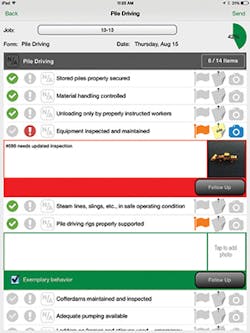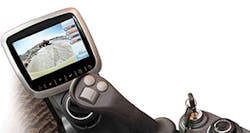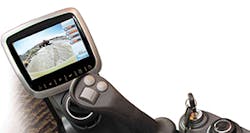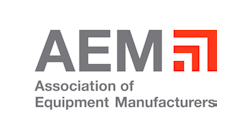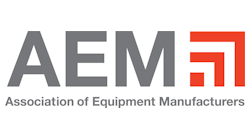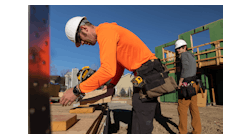There are many challenges contractors face on the job site that necessitate safety practices and technologies, points out Eric J. Herron, global technology marketing consultant, Construction Technology & Solutions–Caterpillar.
Among them: unseen personnel or bystanders; operator fatigue; blind spots and obstructed views; tip overs; damaged existing utilities; collisions with objects or other machines; and poor site conditions such as soft underfoot, unstable soils, and opened excavations.
“Safety is everything. There’s never a compromise,” points out George Chaney, skid-steer loader/compact track loader international sales manager with JCB.
“If a company’s safety performance doesn’t meet the criteria of a client, then they’re not going to get the job,” says Zach Knoop, senior safety consultant for Caterpillar.
LCD screen with video camera
A recent visit to a Texas petrochemical facility drove home the importance of safety equipment and practices on the job for Chaney. His experience speaks to how important it is for grading and excavation contractors to invest in and use safety technology and practices in order to secure good jobs and execute them safely.
“They would not allow you on the job period unless you participated in their introduction safety program, which was very formalized,” says Chaney.
Chaney had been at the facility to train the company’s trainers on some JCB machines.
“We were going through the formal operation of the machine, the safety interlocks, and the owners’/operators’ manuals, and they in turn would provide a formalized safety program for their own employees,” he adds.
At the Texas facility, everyone is required to wear hard hats, high-visibility vests, safety glasses, and steel-toe work boots.
“You had to walk within the allocated areas which were normally delineated with lines on the actual job sites or in the case of outside, areas that were marked for pedestrian and for people movement versus machine movement,” says Chaney.
Employees are required to sign in and out each day, preferably with a scanned ID card.
All employees attend safety training and equipment training with certificates of completion on file with the human resources department.
OSHA requirements are to be followed with respect to wearing vests, hard hats, safety glasses, work boots, and a full body harness if the worker is being elevated up to more than six feet, Chaney points out.
“Up to six feet, it is recommended they have a lanyard for any piece of moving machinery. Ladders are excluded,” he says.
Loose clothing and jewelry that dangles should not be worn around moving machinery, Chaney adds.
Additionally, companies also should conduct periodic random drug and alcohol testing of all employees, Chaney notes.
Industry experts point out that the most important part on a piece of construction equipment is its operator’s manual.
While many seasoned equipment operators feel very comfortable around heavy equipment, “unfortunately, these comfort levels can sometimes lead to shortcuts and sidesteps that can be dangerous and even deadly for operators and those working around them,” points out Tim Boulds, construction product operations manager for Kubota.
“There are many safety precautions that need to be taken into account when operating equipment to avoid common oversights, and it starts with the basics such as reading the operator’s manual and conducting safety checks,” he says.
“Reading an operator’s manual may seem like a tedious task to a veteran contractor,” adds Boulds. “However, it’s important because manufacturers make changes every year. If you don’t familiarize yourself with a new machine and its features, accidents are exponentially more likely to occur.”
Brad Stemper, solutions marketing manager for CASE Construction Equipment, points out that the manuals should be reviewed on a regular basis to “help remind operators of the controls, considerations, and operating parameters specific to that machine.”
Stemper also advises contractors should pay close attention to machine decals and follow their instructions.
Additionally, just as an airline crew performs pre-flight tasks, “there are several basic safety checks that should be conducted prior to starting the engine” of a piece of construction machinery, says Boulds.
For example: An operator should always assess the job site, wear personal protective equipment and visually inspect the machine. All preventative maintenance should be conducted prior to use, such as greasing pivot points and checking the oil and coolant levels.
Surveying the job site before operation offers an understanding of the operating area, adds Stemper.
“This provides awareness of where obstacles may be, whether bystanders are present, and even the warning signs of hazards, like flags or markings identifying underground or overhead utilities,” he says.
And although everyone seems to have more on their plate these days, Stemper says a general rule of advice about safety: “Slow down. Don’t rush into operation.”
The operator must wear a seat belt, lower the lap bars and check all controls to make sure they are in the proper position before starting the machine, says Kubota’s Boulds.
Additionally, the operator should always visually check to verify that everyone is clear of the machine, Boulds points out.
“Depending on requirements of the employer or the job site safety manager, the operator may be required to audibly announce that they are going to start their engine or beep the horn to make those around them aware that the machine is starting,” he says.
Those working at the site should be aware of where equipment is and should listen for back-up alarms, lights and movement, he adds.
To complete the day, operators also should consider doing a post-operation checklist, says Stemper.
“Review how the machine looks. Clean up the job site,” he adds. “Simply looking over the machine will provide insight on service concerns or if any accidents happened with the machine that the operator was unaware of. Cleaning up the job site allows the operator to see differences the next time they return.”
Proper equipment maintenance also plays a significant role in job-site safety, Stemper points out.
“When the machine is performing as it should be, operators can concentrate on the task and be more aware of their actions,” he says. “When that machine is not performing as it should be, operators can spend more time concentrating on the problem, which diverts their attention from the task of operating and awareness around the job site.”
For most companies, there’s a desire to go from a good safety company to a great safety company to achieve excellence in safety and operations, says Knoop.
“There are various tools, processes and technologies to get there. You can utilize technology to give you insight into aspects of the job you didn’t have visibility to before.”
For example, technology offers information on how a machine is being used. Evidence of aggressive operation could be linked to unsafe behaviors, he says.
“You may not have seen that before without having some sort of connection between the machine and a system spitting out information telling you you’ve got these issues,” he says.
As a general rule, design standards normally incorporate machine design requirements, taking into consideration various hazards that the operator may be exposed to during use of the machine,” notes Mark Rangos, general manager of product support for Liebherr.
“Machine stability during application is addressed through standard stability requirements. Noise levels are accommodated within the cab and within certain proximity of the machine according to limits within the standards,” he says. “Visibility is also addressed to require optimum visibility through the use of mirrors and/or rear vision cameras.”
Caterpillar endeavors to help contractors address safety challenges and mitigate risk via various means, notes Herron.
Those solutions center on making operators and pedestrians aware when people are in jeopardy of being struck by equipment and alerting operators to conditions that could cause machines to roll over, he says.
Additionally, there is technology to help identify “potential collisions between our customers’ equipment and other equipment/objects and fatigued operators, alerting them and escalating operational concerns,” says Herron.
Cat Connect DETECT technologies combine safety and monitoring systems to enhance operator awareness, he points out.
Improved visibility on job sites can be attained through increasing awareness of the working area around the machine to give the operator the confidence to work more safely and efficiently and at maximum potential, he adds.
“Cameras also can be used to assist operators with precise control of work tools where there is limited visibility to the tool itself,” says Herron. “Strategic placement of cameras can help the operator accurately guide the work tool. It all adds up to a safer, more productive operation.
“By expanding your view of the working environment around your equipment, you can keep your people and assets safe,” adds Herron. “DETECT technologies include cameras and monitoring systems that expand the operator’s view of the immediate work area around the machine so you know exactly where other machines, objects, and people are for added safety in everyday operation.”
To that end, Caterpillar offers a number of options.
WAVS or Work Area Vision System uses one or more cameras and a color display to provide operators enhanced visibility of their surroundings. The most common configuration of WAVS is a single rear-vision camera. These systems are available on medium and large wheel loaders, off-highway trucks, motor graders, track-type tractors, and wheeled tractor scrapers.
Object detection provides vital range and directional information, points out Herron.
The DETECT system combines multiple cameras and can be combined with multiple radar sensors to detect objects within the critical zones around machines. This provides audible warnings and visual indicators that detail distance and location of detected objects.
DETECT availability is on:
- Motor graders: cameras, object detection, avoidance zones, and operator alerts.
- Excavators: cameras, height/depth alerts, avoidance zones, and operator alerts.
- Wheel loaders and off-highway trucks: cameras, object detection, and operator alerts.
- Articulated trucks: cameras and operator alerts.
- Scrapers, track-type tractors, asphalt compactors, and soil compactors: avoidance zones and operator alerts.
Caterpillar’s radar systems detect machines or objects that fall within pre-defined zones.
“If that zone is entered, then there is a warning to the operator and a view on his camera so he understands somebody is in his zone,” says Herron.
Caterpillar has 3D safety on its grade control and compaction control with avoidance zones that can be set on a map.
“Once the machine enters that area or gets close to it, the operator will receive a warning on his display screen inside of the cab and also get an alert,” says Herron.
“That’s one way to prevent machines from driving into inaccessible areas or those that have poor underfoot conditions. Maybe you want to keep machines out of an area where there is a lot of pedestrian traffic. That’s one way a customer can set up his site.”
For night construction work, the cameras are able to view objects and personnel, but are limited by how much light is on the machine or the site, Herron points out.
“If the machine has LED or HID lights, it’s going to help quite a bit,” says Herron, adding that Caterpillar has updated many of its machines to have brighter light as an option.
“The avoidance zones that are drawn out on the maps are going to show up regardless if you’re in the dark or the light,” he adds.
Herron pointed out that safety technology not only protects operators and others on a construction site, but also allows them to “have more confidence in their production and efficiencies.
“They’re going to be less distracted so they can focus on their work,” he says. “Instead of an operator always looking around, behind or in front, looking around blind spots, if there is technology in place like cameras and radar systems, he’s giving that control over to the machine and can rely on the system to help him see where he can’t.”
In November, Wacker Neuson introduced an improved version of its RTx trench roller. It features a line-of-sight infrared remote control (SC3) designed to offer a safer remote-controlled trench roller in contrast to radio frequency controlled units, notes Dave Schulenberg, compaction product manager.
The RTx now comes with a third receiving eye on the top of unit “which ensures continued smooth operation along the trench without interruption as it travels under shoring cross bars,” he adds.
With the Wacker Neuson’s RTx SC3 (Smart Control 3) unit, the operator remains out of the trench, away from the dust and noise of the machine, but must keep a line-of-sight from the controller to the receiving eye at all times.
“This innovative control technology eliminates dangerous blind spots should the unit move behind obstacles and other obstructions, or should the operator get distracted, keeping the job site and workers better protected,” says Schulenberg.
Radio frequency controls do not safeguard against these blind spots, potentially endangering others on the job site, he adds.
For operator safety, the RTx SC3 has additional built-in safety precautions: The machine will stop moving and vibrating if the operator comes within three feet of the roller’s sensing eyes or releases the controller’s joysticks, ensuring the operator is always at a safe distance from the machine, says Schulenberg.
Wacker Neuson’s infrared remote control features a 16-channel transmission, allowing for multiple machines to be used on the same job site without the threat of interference with one another, he says.
“The infrared system is not subject to radio interference from other job-site systems such as cranes, boom pumps and other radio control equipment,” says Schulenberg. “The infrared remote control box is easy to operate with two joystick levers and is fully enclosed, protecting it from moisture and dirt.”
JCB’s skid-steer and compact machines have a single boom design with left side entry, with the design lending itself to safety and convenience, says Chaney. For all of JCB’s machinery, owner/operator manuals are provided that identify all of the machine’s safety elements. International symbols are placed on the machines.
“Contractors have to wear their seat belts while they operate the machines,” says Chaney. “Our excavators are equipped with reverse alarms or motion alarms, because the machine can go forward or backwards—there isn’t any real reverse.”
Rotating beacons and lights are used to increase overall job-site visibility.
A number of JCB products, such as skid-steers and track machines, include a feature in which when the machine backs up, a piercing alarm sounds and the rear light automatically engage.
On the JCB skid-steer loader and compact track loader, the left hand control pod and seat bar both must be raised to enter the machine. When both are raised, they render the machine inoperative to provide a safe entry and exit for the operator.
“I can engage the parking brake if I’m in the machine and it looks like I’m on an incline and I want to stay there for a period of time,” says Chaney. “I can engage the parking brake manually, but I also can disengage it manually while I’m in the machine. If the machine is to be parked on an incline, it must be turned off in the event that some interlock system may not be fully engaged or working.”
Switches on the dash of the skid-steer engage drive and loader functions allowing the operator maximum productivity and visibility.
“In addition, we have a loader lockout feature so if either of the other two locks is engaged, you can render the motor functions, which are the boom, bucket, and auxiliary hydraulics, inactive,” says Chaney. “You have to go through a process to re-engage those functions.”
JCB’s safety technology follows ISO-SAE standards with such features as the rear work lights engaging when the machine goes backwards, he adds.
Kubota offers a range of accessories to enhance the versatility, productivity and safety of equipment on the job site, says Boulds.
“For example, canopy lights are available on Kubota excavators for increasing working area visibility and to extend work hours into the night or on darker days to illuminate the surrounding area,” he says.
In areas with a lot of foot traffic, strobe light kits or a rotating beacon light kit are safety features to consider for compact track loaders.
“Mirror kits are available to increase rear visibility for the operator to monitor movement of construction vehicles, equipment, and personnel within the work zone,” says Boulds. “Travel alarms make it easy to alert others on the job site that your equipment is on the move.”
To assist contractors in executing jobs safely with their machines, Stemper says CASE “has made a concerted effort to increase visibility across all product lines. Rear visibility, visibility down to the tool or attachment, and visibility down to the tracks or tires are all critical in both productive operation and job-site safety. This is an engineering consideration from the first steps of development.”
Light is a critical visibility and awareness issue with twilight and night work.
“CASE has extensive lighting packages available as optional equipment across all product lines, and most products come with robust standard lighting packages,” notes Stemper.
CASE also has standard and optional rear and side view cameras that are available across certain product lines.
“These cameras, matched with improved in-cab displays, can serve to improve operator awareness of the job site around them,” says Stemper.
Stemper points out that while telematics is often regarded as a productivity and efficiency enhancer, it also plays a role in job-site safety.
“A business owner or fleet manager can review telematics data and identify abnormalities in equipment operation that may indicate unsafe operation, and then coach that operator on safer, more efficient methods of operation,” he says.
The aftermarket segment offers options to augment what equipment manufacturers put on machines as standard safety options.
Products such as those offered by Intec Video Systems are designed to “protect people and equipment due to accidents caused by blind spots, primarily when backing, but also blind spots to the side and even looking forward,” points out John DeFazio, mining and construction business development at Intec. “With a camera pointing into those blind areas, the operator can see and prevent an accident. It pays for itself over time by preventing just one accident.”
There’s another benefit to the use of camera systems, says DeFazio.
“A lot of times, the video also is used for the actual productivity of the machinery,” he says. “For instance, you might have a grader and have difficulty seeing the blade, so you’re able to view the blade to get a better cut. You’re able to see in the hopper of a truck to see if you’re overloading or it’s off to one side. With a street sweeper, you can see the broom as it brushes into the corner of the curb.”
To illustrate the importance of safety features on construction equipment, consider the loader.
“It’s backing as much as it’s moving forward and there are blind spots surrounding the loader, with the probability of an accident occurring,” says DeFazio. “With a video system, the operator is able to back with full confidence that it’s clear. He doesn’t have to turn around and twist his neck—he can just glance at the display and have full wide angle vision of what’s occurring back there.”
The camera covers a wider area than can be managed by the naked eye, points out DeFazio.
“You’d have to turn your head three times from the right to the middle to the left to cover the space of the wide angle view. By turning around, you create knots in your neck, which sometimes leads to absentee problems for companies,” he says. “All of that information is going to be condensed to a screen immediately in front of the operator’s eyes.”
For commercial and industrial type heavy-duty equipment use, Intec Video Systems offers the Car Vision line to help contractors identify blind spots on mining and construction equipment, such as loaders and excavators.
The line includes black and white cameras, color cameras, and flush and side mount cameras.
The Car Vision system’s angle view is 125 degrees horizontal and 100 degrees vertical. It can be used on any piece of equipment typically found in a confined area, such as loaders, excavators, and articulated trucks, says DeFazio.
The system also is effective for nighttime construction, comments DeFazio.
“The camera and the systems are more light sensitive than the naked eye, so whatever you can see with your naked eye, you’re going to see better with the video system,” he adds.
Military connectors are used on the system for durability, given that a construction site is a challenging environment, says DeFazio. The system is waterproof and submergible.
The system also uses polyurethane cables “because they remain flexible in very hot and cold temperatures,” notes DeFazio.
An integrated radar system gives off rapid-sound tones and flashing light bars on the display.
“That’s an option if the customer wants to add it to the video that works in conjunction with the video, so if a piece of equipment is backing and there’s an object, whether it be a person or a truck behind you, then the radar will sense that and warn the operator with an audio sound or the visual appearance of the LED display flashing to alert them that something is there,” says DeFazio.
PreView is a solid-state, pulsed radar object detection system, which is designed to alert vehicle operators to detected moving and stationary obstacles in a pre-defined coverage area. It reports the distance of the closest object to the vehicle operator through visual range indicators built in to the Intec CVD series of Car Vision displays and an audible alert through the remote.
The sensor assembly transmits and receives low power 5.8 GHz radar signals, processing the returned signals to determine if an object has reflected any energy back to the sensor and reporting it back to the operator through the Intec video display within a half of a second.
The connections to the vehicle are made with the interface harness, with power drawn from the vehicle reverse circuit. The sensor RF output is pulse-modulated as to not interfere with similar devices.
No matter what technology is employed, it’s important to choose the right technology and be able to support it, says Knoop.
“If you can’t support it, there’s no reason to use it,” he adds. “A lot of organizations purchase great technology, but they never really take advantage of it because they don’t have a system in place to support it, manage the data, evaluate what it’s trying to tell you and what you need to do about it and react to it in a proactive way.”
Looking ahead, Caterpillar is pursuing new technologies to enhance safety technologies, such as systems that use antennae and wearable RFIDs that will track personnel and objects on a job site as well as advanced camera systems that are able to provide a 360-degree view of a machine or provide intelligent detection of objects and personnel.
“There’s technology that allows the machine to communicate with an employee that’s equipped with an RFID device so they can talk to one another,” says Knoop. “Now you have the ability to make people more present to other people in machines.”
According to Steve McGough, President and Chief Operating Officer of HCSS, safety is everyone’s business. “An effective safety program is born in the office and carried out in the field, offering a unique set of challenges for construction companies. Technology, such as true end-to-end sophisticated Safety Management Systems (SMS), can meet those challenges and thus save lives and otherwise improve workplace safety. Software cannot replace the need for a strong safety program, but the right technology can transform it into an inherent ‘safety culture’ where safety is second nature to every employee in the company.
“SMS can proactively organize and manage all safety information, provide interactive reports and predictive trends from leading and lagging indicators, and display live job-related data to keep everyone involved up-to-date and informed,” McGough continues. “Corrective actions and follow-ups can also be assigned and automated to complete audit loops. These products should also closely integrate with bidding applications and project management systems to garner true potential of the safety data.”
